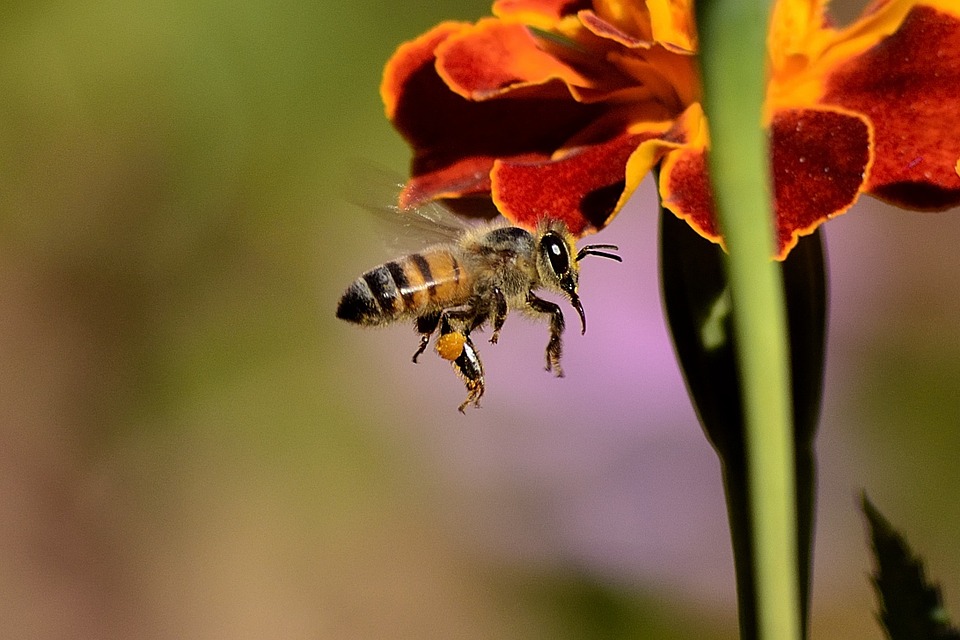The global decline of different species of bees (both honey and native bees) have been contributed by a number of important factors like rapid and unrestricted pollution of the environment, overuse of various agro-chemicals under our modern, global industrial agricultural regime, rapid changes in the land use patterns, parasitic diseases of the bees caused by the Varrora destructor mite infestations along with the infamous Colony Collapse Disorder to mention only a handful. The loss of several important melliferous and pollinator friendly plant species from our local ecosystems and environment due to negative anthropogenic influences have also been seriously impacting global bee populations. The lack of adequate supply of pollen and nectar due to shortage of appropriate melliferous flora for foraging bees has been impacting bee nutrition and bee health.
Bees are extremely important biological agents for natural cross-pollination in several species of plants and crops. Hence, the sad demise of bees could have serious implications for the future of modern agriculture and apiculture industries; impacting the life and livelihood of millions of individuals across the planet. Bees being an important constituent of our natural ecosystems, the alarming decline of bee populations around the planet can also destabilize the synchrony of the fragile local ecosystems and the environment in a significant manner.
A vast majority of important food and commercial crops are dependent on natural pollinators such as insects like bees, moths, butterflies, and some species of flies and beetles; certain species of snails and slugs, humming birds and bats for the purpose of cross pollination. The roles of several small amphibians like certain tree frog species and other small vertebrates are also now being investigated in different tropical and sub-tropical environments.
Bees and other insect pollinators is an important constituent of our natural ecosystems. The rapid decline of bees has the potential of negatively impacting the life and livelihood of millions of people around the globe due to their close association to agriculture and apiculture for their daily sustenance. Hence, conservation of bees and other insect pollinators; and securing their existence is important both in terms of ecology and environment as well as economy. Bees and other insect pollinators play a significant role in the survival and reproduction of numerous plant species; thereby, providing an invaluable natural ecological service.
Under these circumstances, it is important to develop some long term and sustainable strategies to protect the vulnerable bee (both honey bees and native/indigenous bee species) and other insect pollinator species (moths, butterflies, certain species of beetles and flies). One of the simplest eco-environmentally sensitive, long term and sustainable strategy could be developing suitable bee or pollinator gardens or bee habitats or bee sanctuaries at suitable sites.
Pollinator (bee) gardens or habitats or bee sanctuaries could be established at several ideal places that can serve as undisturbed ecological habitats adjacent to irrigation canals or waterbodies like ponds, swamps, ditches, pools, small streams, river beds etc. Pollinator (bee) gardens or habitats or sanctuaries can also be established outside farming areas that are usually non-cultivated, impacted with salt related issues, hard to access areas of farms (either abandoned or otherwise agronomically unsuitable sites), forest fringes, city, town or municipality maintained parks and gardens, private or public lawns, backyard kitchen gardens, unused or under utilized sections of city or municipal roads or rural pathways to mention a handful target sites.
It is important to include native/indigenous wildflowers (melliferous flora) that can easily attract insect pollinators in large numbers to such pollinator (bee) habitats or sanctuaries. Furthermore, mixes of annual/biennial/perennial pollinator attracting crop species (such as forage crops) may also be grown in sites to add to the pollinator (bee) diversity to such sites as Pollinator Mixes. Mixture of native grasses and wildflowers together with forage crops can serve as an important choice as Pollinator Mix. Including annual/perennial legume forages in the mix can not only help attracting bees and other insect pollinators; but can also easily help in fixing nitrogen into the soil.
Thus Pollinator Mixes grown in abandoned and otherwise agriculturally unsuitable sites could benefit provided by phytoremediation services provided by the native or forage grasses as well as will be enriched by nitrogen fixed by legumes in the mix included in the mix. The leaf litter ad dead and decaying plant matter will serve as organic compost for such sites; helping seeds shed by the pollinator crops to regrow and maintain the sites without additional management labor and cost.
Some reseeding and minimal care will be off course necessary to remove unwanted weeds in the pollinator patches. However, care must be taken to avoid spraying any toxic pesticides in such patches to avoid negatively impacting bees and other insect pollinators in the pollinator habitats or sanctuaries. Over the time, such pollinator gardens or habitats or sanctuaries if well established; will also attract other insects, local reptiles and amphibians, small birds and mammals and hence develop into complex natural ecological units that can successfully conserve local biodiversity.
Pollinator habitats or sanctuaries adjacent to waterbodies can also contribute towards conservation of both terrestrial as well as aquatic species and broaden the umbrella of protection for a number of local species. Aquatic habitats with pollinator crops will also attract fowls and aquatic birds to nest, breed and forage in such natural and/or artificial ecosystems developed in the line of Multiple Tier Conservation Model (MTCM) supporting ecosystems at different trophic levels. Pollinator habitats or sanctuaries could be developed under a multi-trophic level Integrated Ecological Habitat Development for Bees, Birds and Fishes (IEHD-BBF) model to cater to a wider diversity of local species with long term implications for successful conservation.
